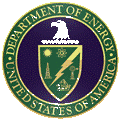United States Department of Energy

United States Department of Energy: Publications
Date of this Version
2004
Citation
Geochimica et Cosmochimica Acta, Vol. 68, No. 15, pp. 3171–3187, 2004
Abstract
The potential for reduction of 99TcO4-(aq) to poorly soluble 99TcO2 · nH2O(s) by biogenic sediment-associated Fe(II) was investigated with three Fe(III)-oxide containing subsurface materials and the dissimilatory metal-reducing subsurface bacterium Shewanella putrefaciens CN32. Two of the subsurface materials from the U.S. Department of Energy’s Hanford and Oak Ridge sites contained significant amounts of Mn(III,IV) oxides and net bioreduction of Fe(III) to Fe(II) was not observed until essentially all of the hydroxylamine HCl-extractable Mn was reduced. In anoxic, unreduced sediment or where Mn oxide bioreduction was incomplete, exogenous biogenic TcO2 · nH2O(s) was slowly oxidized over a period of weeks. Subsurface materials that were bioreduced to varying degrees and then pasteurized to eliminate biological activity, reduced TcO-4(aq) at rates that generally increased with increasing concentrations of 0.5 N HClextractable Fe(II). Two of the sediments showed a common relationship between extractable Fe(II) concentration (in mM) and the first-order reduction rate (in h-1), whereas the third demonstrated a markedly different trend. A combination of chemical extractions and 57Fe Mossbauer spectroscopy were used to characterize the Fe(III) and Fe(II) phases. There was little evidence of the formation of secondary Fe (II) biominerals as a result of bioreduction, suggesting that the reactive forms of Fe(II) were predominantly surface complexes of different forms. The reduction rates of Tc (VII)O-4 were slowest in the sediment that contained plentiful layer silicates (illite, vermiculite, and smectite), suggesting that Fe(II) sorption complexes on these phases were least reactive toward pertechnetate. These results suggest that the in situmicrobial reduction of sediment associated Fe(III), either naturally or via redox manipulation, may be effective at immobilizing TcO4- (aq) associated with groundwater contaminant plumes.

